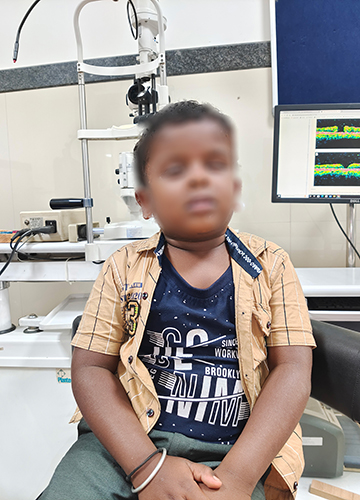Aadharv was like any toddler—cheerful and playful. But then his mother Shanthamma, like any mother attuned to her child’s needs, noticed him having trouble locating his toys. He would also ram into the walls and doors of his home in Kolar, some 65km from Bengaluru. Based on Shanthamma’s hunch, Aadharv (name changed) was taken to an eye specialist. A medical examination revealed a white reflection or glint in Aadharv’s eyes. He was referred to the Sankara Eye Hospital in Bengaluru, where he was diagnosed with retinoblastoma—a rare cancer of the retina (that sense light) that mostly occurs in children below six. Aadharv was only two.
At the hospital’s ocular oncology centre, a staging of the tumour was done as per the International Classification for Intraocular Retinoblastoma. Aadharv’s tumour was group E, and so large that there is little chance of saving the eye. Since the cancer had affected both his eyes, he was started on chemotherapy. But his left eye was not responding to the chemotherapy, and the doctors were forced to remove the tumour and his left eye to prevent the cancer from spreading to other parts of his body.
“When the patient came to us, he was blind as both his eyes were severely affected,” said Dr Mahesh Shanmugam, head of ocular oncology and vitreoretinal diseases, Sankara Eye Hospital. “The right eye responded well to both chemotherapy and radiation therapy and the sight was restored. But the child lost vision once again as he developed bleeding inside the eye. We performed vitrectomy (removal of the vitreous humor—the transparent jellylike tissue filling the eyeball behind the lens) to restore the vision. It is a rare surgery as incisions are done into the eye, which poses the risk of metastasis (tumour cells spreading outside the eye). The procedure took 45 minutes under general anaesthesia; the child was treated in the outpatient department.”
Shanmugam warns of possible complications of retinoblastoma, like a detached retina, metastasis and loss of eyesight. Then there are the side effects of chemotherapy such as tiredness, bruising and bleeding, mouth sores, infections, vomiting and diarrhoea and also bleeding or infection from surgery. So, a regular followup is necessary to rule out any complications. Glasses are prescribed to help the child have normal vision.
Retinoblastoma is a curable cancer, if detected early. The cancer may be passed on from parents (inherited) or it may occur by chance (sporadic). The cancer is caused by a mutation in the RB1 gene. It also increases the risk of bone and soft tissues cancer and skin cancer. The most common symptoms are an abnormal white reflection in the retina and misaligned or squint eyes, said doctors.
“At least 60 per cent of retinoblastoma cases are sporadic and 40 per cent familial,” said Shanmugam. “If it is familial, the chances are both eyes could be affected and the child is prone to other tumours later on in life as the gene that protects against developing tumours is missing in the patients.”
Retinoblastoma can be detected at 12 months in genetic retinoblastoma and between 18 and 24 months in sporadic retinoblastoma. But early detection has remained a challenge, said doctors. “Newborns can be tested by examining the pupil,” said Shanmugam. “But since the incidence of the disease is one in 10,000 live births, the cost versus benefit is low and it is not part of routine screening in hospitals.” Also, regular health screening programmes in schools pick up cases of poor vision and squint eyes, but that screening is not helpful to detect retinoblastoma as it affects the pre-school age group (below six years).
The treatment for retinoblastoma is a combination of surgery, chemotherapy, brachytherapy (placement of radioactive implant close to the base of the tumour), laser therapy and cryotherapy (freezing the tumour). In Aadharv’s case, the treatment involved six cycles of chemotherapy, brachytherapy and surgeries to remove the tumours, vitreous humor and the left eye. The treatment cost depends on the number of cycles of chemotherapy required and the services of specialists availed as it demands team work—from an ophthalmologist, paediatrician, paediatric surgeon, paediatric oncologist to retina specialist, radiation oncologist and anaesthetist.
Shanthamma had never heard of retinoblastoma before Aadharv’s diagnosis. She has three daughters, and none of them has the rare disease. But she has put the ordeal behind her and is happy with Aadharv’s recovery. He is six now. “He is in class 1 and wears glasses,” she said. “He uses eye drops before going to bed. I take him for a followup once in three months.”



